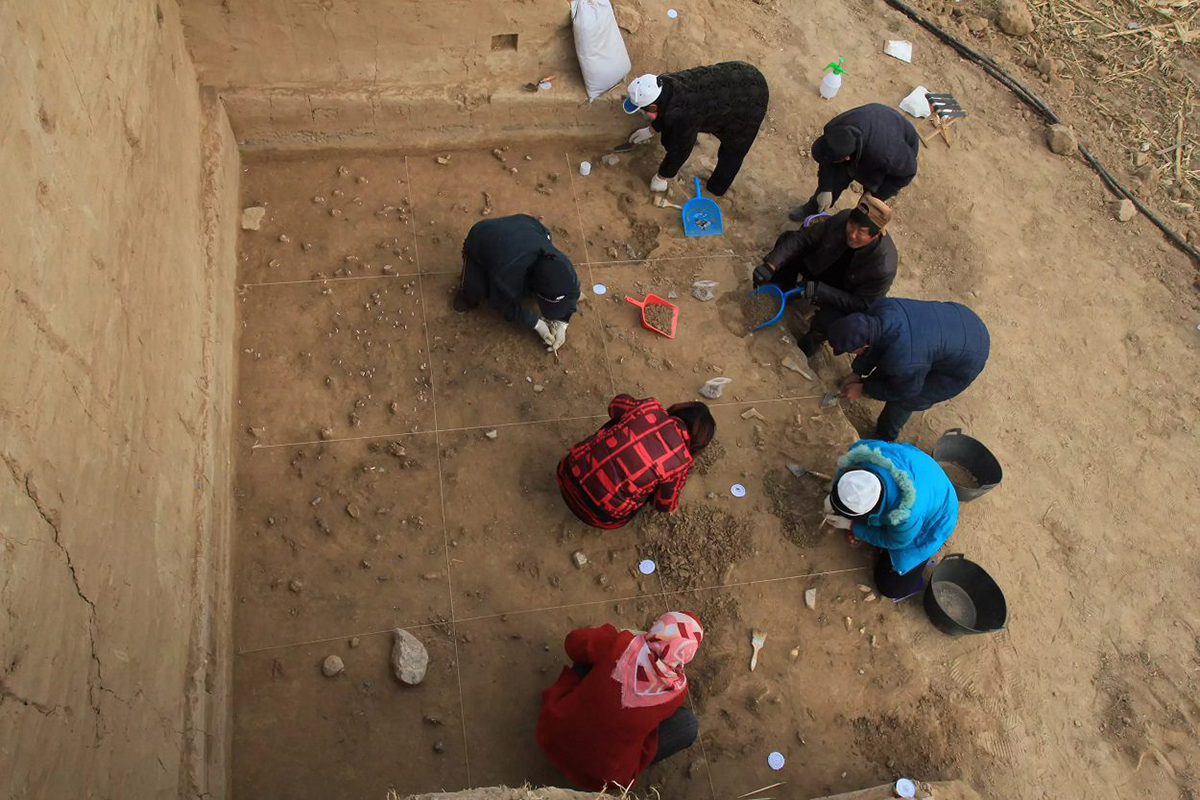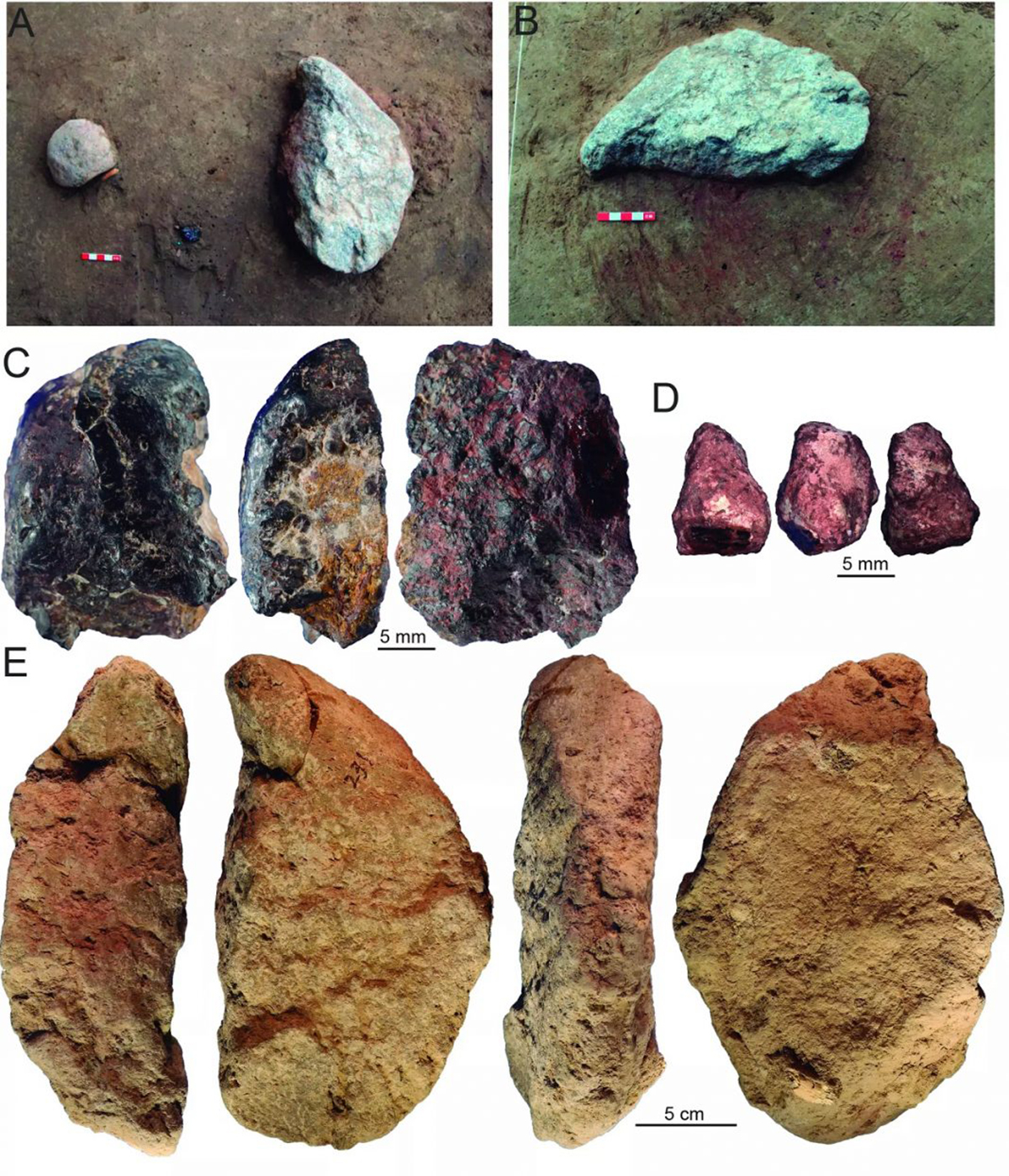


An article by the Max Planck Institute for the Science of Human History on heritagedaily.com - Archaeologists uncover previously unidentified set of cultural innovations from 40,000 years ago - reports on the excavations in northern China which have revealed a previously unknown set of cultural innovations in the Nihewan Basin.

Previous studies of the Nihewan Basin have led to the discovery of a wealth of archaeological sites, ranging in age from 2 million to 10,000 years ago, with the new study focusing on the site of Xiamabei which has been published in the journal Nature and describes a unique 40,000-year-old culture.
With the earliest known evidence of ochre processing in Eastern Asia and a set of distinct blade-like stone tools, Xiamabei contains cultural expressions and features that are unique or exceedingly rare in north-eastern Asia. Through the collaboration of an international team of scholars, analysis of the finds offers important new insights into cultural innovation during the expansion of Homo sapiens populations.

Dr. Fa-Gang Wang of the Hebei Provincial Institute of Cultural Relics and Archaeology whose team first excavated the site said: “Xiamabei stands apart from any other known archaeological site in China, as it possesses a novel set of cultural characteristics at an early date.”
“The ability of hominins to live in northern latitudes, with cold and highly seasonal environments, was likely facilitated by the evolution of culture in the form of economic, social and symbolic adaptations” added Dr. Shixia Yang, researcher with the Chinese Academy of Sciences and the Max Planck Institute for the Science of Human History.
The researchers found that Xiamabei presents an extensive use of ochre, as shown by artefacts used to process large quantities of pigment. Discoveries include two pieces of ochre with different mineral compositions and an elongated limestone slab with smoothed areas bearing ochre stains, all on a surface of red-stained sediment.
An analysis by researchers from the University of Bordeaux, led by Prof. Francesco d’Errico, indicates that different types of ochre were brought to Xiamabei and processed through pounding and abrasion to produce powders of different colour and consistency, the use of which impregnated the habitation floor. Ochre production at Xiamabei represents the earliest known example of this practice in Eastern Asia.
The stone tools at Xiamabei represent a novel cultural adaptation for northern China 40,000 years ago. Because little is known about stone tool industries in Eastern Asia until microblades became the dominant technology about 29,000 years ago, the Xiamabei finds provide important insights into toolmaking industries during a key transition period.
The blade-like stone tools at Xiamabei were unique for the region, with the large majority of tools being miniaturised, more than half measuring less than 20 millimetres. Seven of the stone tools showed clear evidence of hafting to a handle, and functional and residue analysis suggests tools were used for boring, hide scraping, whittling plant material and cutting soft animal matter. The site inhabitants made hafted and multipurpose tools, demonstrative of a complex technical system for transforming raw materials not seen at older or slightly younger sites.
The record emerging from Eastern Asia shows that a variety of adaptations were taking place as modern humans entered the region roughly 40,000 years ago. Although no hominin remains were found at Xiamabei, the presence of modern human fossils at the contemporary site of Tianyuandong and the slightly younger sites of Salkhit and Zhoukoudian Upper Cave, suggests that the visitors to Xiamabei were Homo sapiens.
A varied lithic technology and the presence of some innovations, such as hafted tools and ochre processing, but not other innovations, such as formal bone tools or ornaments, may reflect an early colonisation attempt by modern humans. This colonisation period may have included genetic and cultural exchanges with archaic groups, such as the Denisovans, before ultimately being replaced by later waves of Homo sapiens using microblade technologies.
Given the unique nature of Xiamabei, the authors of the new paper argue that the archaeological record does not fit with the idea of continuous cultural innovation, or of a fully formed set of adaptations which enabled early humans to expand out of Africa and around the world. Instead, the authors argue that we should expect to find a mosaic of innovation patterns, with the spread of earlier innovations, the persistence of local traditions, and the local invention of new practices all taking place in a transitional phase.
“Our findings show that current evolutionary scenarios are too simple,” says Professor Michael Petraglia of the Max Planck Institute in Jena, “and that modern humans, and our culture, emerged through repeated but differing episodes of genetic and social exchanges over large geographic areas, rather than as a single, rapid dispersal wave across Asia.”
by Bradshaw Foundation
Monday 04 December 2023
by Bradshaw Foundation
Friday 30 June 2023
by Bradshaw Foundation
Thursday 06 April 2023
by Bradshaw Foundation
Thursday 24 November 2022
by Bradshaw Foundation
Tuesday 27 September 2022
by Bradshaw Foundation
Thursday 08 September 2022
by Bradshaw Foundation
Tuesday 19 July 2022
by Bradshaw Foundation
Monday 06 June 2022
by Bradshaw Foundation
Friday 11 March 2022
by Bradshaw Foundation
Wednesday 02 March 2022
by Bradshaw Foundation
Thursday 26 August 2021
by Bradshaw Foundation
Monday 16 August 2021
by Bradshaw Foundation
Tuesday 06 July 2021
by Bradshaw Foundation
Thursday 06 May 2021
by Bradshaw Foundation
Thursday 06 May 2021
by Bradshaw Foundation
Tuesday 16 March 2021
by Bradshaw Foundation
Monday 04 December 2023
by Bradshaw Foundation
Friday 30 June 2023
by Bradshaw Foundation
Thursday 06 April 2023
by Bradshaw Foundation
Thursday 24 November 2022
by Bradshaw Foundation
Tuesday 27 September 2022
by Bradshaw Foundation
Thursday 08 September 2022
by Bradshaw Foundation
Tuesday 19 July 2022
by Bradshaw Foundation
Monday 06 June 2022
by Bradshaw Foundation
Friday 11 March 2022
by Bradshaw Foundation
Wednesday 02 March 2022
by Bradshaw Foundation
Thursday 26 August 2021
by Bradshaw Foundation
Monday 16 August 2021
by Bradshaw Foundation
Tuesday 06 July 2021
by Bradshaw Foundation
Thursday 06 May 2021
by Bradshaw Foundation
Thursday 06 May 2021
by Bradshaw Foundation
Tuesday 16 March 2021
Friend of the Foundation











